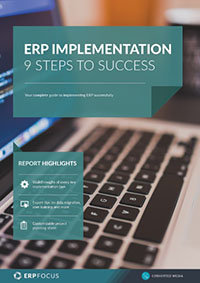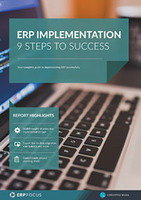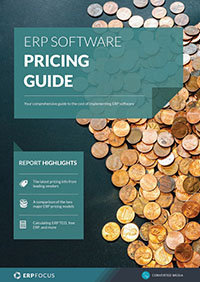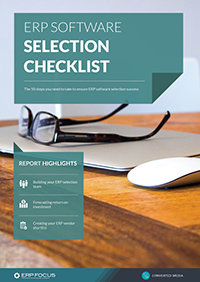ERP migration steps (your ERP migration checklist)
Your ERP migration is one of the most significant phases of your ERP project. This is when everything finally comes together, and your system becomes fully operational.
However, an ERP migration is much more than just moving data. It involves careful planning, collaboration across departments and thorough testing to ensure success. Here, we’ll break down the essential steps in your ERP migration and provide additional insights into the process, timeline and costs.
Table of contents:
- What is an ERP migration?
- Step #1: ERP Requirements
- Step #2: Planning your ERP migration
- Step #3: Communication
- Step #4: Execution
- Step #5: Managing the change to a new ERP system
- Step #6: ERP go-live and evaluation
- How long does an ERP migration take?
- How much does an ERP migration cost?
What is an ERP migration?
ERP migration is the process of transferring your business's data, processes and workflows from one system to another. This can involve upgrading an existing ERP system, transitioning from a legacy system to a new one, or moving from an on-premises ERP to a cloud-based solution. The goal of ERP migration is to improve the business’s operational efficiency, ensure data accuracy, and align the system with the company's future goals.
Migrating to a new ERP system can be daunting, but breaking it down into clear steps helps make the process manageable. Below is a six-step ERP migration checklist to guide you.
Step #1: ERP requirements
Your ERP requirements are the foundation. At the end of your journey, those requirements should be met completely. You and your team worked hard to develop those requirements. You met in person, over the phone, and through written words over an extended period. You have a prioritized list that you all agree will help your business meet the needs of customers and other stakeholders.
Your team also kept additional desires labeled “nice to have,” which can aid your business or parts of it, but were less important, or you had sufficient workarounds.Beyond simply documenting the requirements you have listed, you worked with your executives to ensure the requirements you have met their future needs as well. You and your migration team might not be aware of some plans for the future. Even more importantly, without the support and backing of those executives, your software migration plans and hopes could quickly be swept away.
This step-by-step ERP implementation guide will help you plan a smooth and successful ERP migration
Step #2: Planning your ERP migration
You have a detailed plan to move from your current status to the end of your migration. That plan includes dates and milestones along the way so you can monitor your progression. There are many steps to be taken. Data migration is among the first steps.
The new ERP needs to be filled with data, much of which will come from your legacy systems. There are several data categories, each requiring different techniques. Fixed data includes basics like your tax ID and address, often typed directly into cells, as well as customer and supplier names and addresses. Start by identifying where this data will reside in your new ERP, which will be fields within tables.
Find the same data elements in your legacy system and map them, indicating that table 1 and data A in the new system will come from table 14 field 23 in the legacy system. Check if any data needs conversion, such as transforming date formats.
New ERP data validation rules must be followed or temporarily removed during migration. These rules may require one table to be populated before another or ensure dates in one table precede those in another.
Document the data migration process and track the time required for each step. Your data migration will be done several times during your upcoming testing and again just at your final go-live date. Testing might alert you that some part of your initial data plan must be changed in some unanticipated way.
Step #3: Communication
Communication is crucial for ERP migration success. This is not just an IT project; it's an enterprise-wide initiative that affects everyone. Let everyone know why the business is migrating to a new ERP system and what the expectations for the business are. Ideally, there are benefits to all users but even those who get no new benefits will gain when the enterprise as a whole benefits.
Be prepared to address the following concerns:
- There will be greater profits for all to share, won’t there?
- When will the project begin and when do you expect it to be completed?
- What kind of hardships might users encounter during the project?
- Who will be doing the work and who will fill in for them while they are working on the ERP migration?
- Will any benefits begin to accrue before completion?
- What work will people see as the project moves forward?
- Who are the strangers (consultants) setting up shop already?
- What can individuals do to help?
- Who can one talk to if they do not understand or disagree with this new direction?
- Will anyone lose their job because of this change?
Your communications at this time are only the beginning. Make a pact with your employees now to keep good communications throughout the migration.
Step #4: Execution
Let the migration begin! Hold a kickoff meeting where the migration teams get their assignments and get some enthusiasm for their efforts and some recognition from their peers for the work they are embarking on at this time.
Populate your new ERP with data from your legacy systems. Begin testing simple transactions in teams from each department. Simple transactions are ones like receiving a part into inventory or writing a check. Later you will test multi-stage transactions that might include recognizing the liability the check pays for and reconciling the bank account to show the check cleared.
Grade each test with a simple status: Green for successful transactions, Yellow for successful but with issues, and Red for failures. Investigate all non-green transactions to identify issues. If the team can't find the reason, seek help. There should be no red results and very few yellow ones at go-live. Check for incorrect setup, wrong instructions, or migrated data problems. Understanding and correcting testing issues is crucial.
Testing is an iterative process. Fixing one problem can lead to a new, unexpected problem. A test that passed as green yesterday can move to red today because a fix was entered to correct some other test.
Single transaction testing will lead to tests that combine multiple transactions in an overall process. Instead of just receiving that part into inventory, you'll create the purchase order, receive the part, perform quality inspections, and then stock it. These combined tests will yield green, yellow, or red results. Your final tests will be complex, possibly involving taking a customer order, buying and making a product, shipping it, collecting payment, paying suppliers and employees, and creating an income statement.
During testing, you'll need to repeatedly update data migration from your legacy system. Sometimes it's to create a fresh system for tests; other times, to fix faults in imported data. Repeated imports offer practice and improved techniques. You must know how to manage the import process at go-live and how long it will take, as your business will pause while the legacy systems stop and the new ERP isn't ready yet.
Step #5: Managing the change to a new ERP system
Migrating to a new ERP will cause stress for your employees, the implementation team, your customers, and your suppliers. Helping all of these stakeholders manage the change they see or anticipate is important.
Some of the change is overwork as people try to keep up with their jobs in the legacy system and prepare for their job in the new. Some stress comes only from change. Some people have a difficult time making any kind of change, even one clearly for some better state. There might be others who do not agree that the change to a new ERP is beneficial to them or even to the enterprise.
Part of the migration efforts is to help all these people manage change as they understand it. Some of the help is psychological and you might want to employ experts to help. Ensuring that all get adequate training will help most people get beyond fear. Once they see the new ERP and understand their work can still be done satisfactorily many will accept the change.
Watch for hidden signs of stress. Not everyone’s stress is obvious and not everyone will ask for help. Use all your senses and try to help as much as possible to keep any stress from reaching a critical level.
Step #6: ERP go-live and evaluation
Here is where the migration project begins to end. This could be the hardest workday of your life so get a good rest if you can. The testing is complete and the results are good. All the users have passed their training. Anticipation is mounting.
Your team has set a specific time of a certain day when new transactions in the new ERP will begin. A few hours earlier, probably in the dead of night, your computer folks stopped your legacy systems from any new transactions and switched the data to a read-only mode. The final data migration started and it should be completed well ahead of the go-live moment. Your team has a few final checks when the data migration is complete to ensure all is well.
Someone entered the first transaction and it worked! Hooray! But now you find that many people suddenly forget all that training and need their hands held as they start using the system. Soon, all seems well and the team heads for home and collapses into their beds after a really long day.
Wait a while, then look again at your ERP requirement list. Does the new ERP actually meet them all? Add up the value of the benefits and compare them to the actual costs of your migration. Is the ROI what was expected? Document the project for reference later as you want to retain your group’s learning.
How long does an ERP migration take?
The duration of an ERP migration depends on the complexity and scope of the project, but it generally takes anywhere from three months to two years. Factors influencing the timeline include the size of the organization, the quality of data, the complexity of processes and the chosen ERP system.
How much does an ERP migration cost?
The cost of ERP migration varies based on factors like organization size, process complexity, and customization needs. A mid-sized business with 100 users might pay $170,840 annually over 5 years. This includes the system itself, implementation costs, data migration, consulting, basic configurations and minimal customizations.
How key factors may affect costs:
- Customization and integration: The more you tailor the ERP system to fit your specific business processes, the higher the cost. Highly customized ERP systems can involve significant expenses for development and integration.
- Consulting and professional services: Hiring external consultants for system implementation, migration support and user training can add substantial costs to your migration project.
- Training and change management: Ensuring that employees are properly trained and managing the transition are both critical for success but can also be costly.
Free white paper

ERP Implementation: 9 steps to success
The 9 proven steps you should follow when implementing ERP

Featured white papers
-

ERP Software Pricing Guide
Get the latest pricing information on over 80 popular ERP systems, and learn how to budget for your ERP project in our free guide
Download -

60-Step ERP Selection Checklist
Get the comprehensive checklist for your ERP selection project
Download -

ERP Implementation: 9 steps to success
The 9 proven steps you should follow when implementing ERP
Download
Related articles
-

4 practical examples of the power of real-time ERP data
Discover the potential of real-time data with these practical examples from a range of industries.
-

CMMC Compliance: What Aerospace and Defense Manufacturers Need to Know
Key insights on CMMC compliance, deadlines, and securing DoD contracts with CMMC 2.0 certificatio...
-

The ERP go-live data load
Why proper migration of your data is integral to a successful ERP implementation

